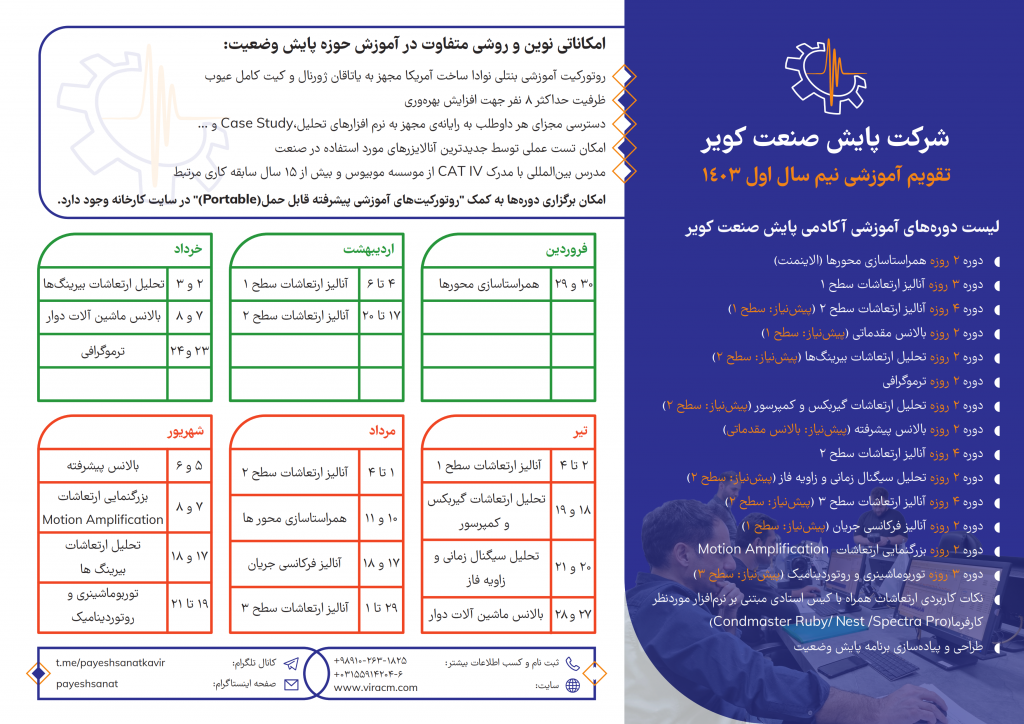Register Link for PAYESH SANAT KAVIR Courses
ثبت نام در دورههای پایش صنعت کویر
Training with testing AND Analysis
تقویم آموزشی دوره های داخلی
Payesh Sanat Kavir Course Calendar

Register Link for PAYESH SANAT KAVIR Courses
ثبت نام در دورههای پایش صنعت کویر
Training with testing AND Analysis
تقویم آموزشی دوره های داخلی
Payesh Sanat Kavir Course Calendar

Permissible residual specific unbalance based on balance quality grade G and service speed n
Experimental evaluation
Experimental evaluation of the balance quality requirements is often carried out for mass production applications. Tests are commonly performed in situ. The permissible residual unbalance is determined by introducing various test unbalances successively in each correction plane, based on the most representative
criterion (e.g. vibration, force, noise caused by unbalance).
In two-plane balancing, if no tolerance planes (as specified in 4.4) are used, the different effects of unbalances with the same phase angle and of those 180 apart shall be taken into account.
ISO21940-1
ISO 10814:1996
Gives methods for determining machine vibration sensitivity to unbalance and provides evaluation guidelines. Makes recommendations on how to apply the numerical sensitivity values in some particular cases.
ISO 10814:1996 Withdrawn with ISO 21940-31:2013
ISO 21940-31:2013
Introduction
Rotor balancing during manufacture is normally sufficient to attain acceptable in-service vibration magnitudes if other sources of vibration are absent.
However, additional balancing during commissioning may become necessary and after commissioning,some machines may require occasional or even frequent rebalancing in situ.
If vibration magnitudes are unsatisfactory during commissioning, the reason may be inadequate balancing or assembly errors. Another important cause may be that an assembled machine is especially sensitive to relatively small residual unbalances which are well within normal balance tolerances.
If vibration magnitudes are unsatisfactory, the first step often is an attempt to reduce the vibration by balancing in situ. If high vibration magnitudes can be reduced by installing relatively small correction masses, high sensitivity to unbalance is indicated. This can arise, for example, if a resonance rotational
speed is close to the normal operating speed and the damping in the system is low.
A sensitive machine which is also highly susceptible to its unbalance changing, may require frequent rebalancing in situ. This may be caused, for example, by changes in wear, temperature, mass, stiffness, and damping during operation.
If the unbalance and other conditions of the machine are essentially constant, occasional trim balancing may be sufficient. Otherwise it may be necessary to modify the machine to change the resonance speed, damping or other parameters to obtain acceptable vibration magnitudes. Therefore, there is a need to consider permissible sensitivity values of the machine.
The repeatability of the unbalance sensitivity of a machine is influenced by several factors and may change during operation. Some thermal machines, especially those with sleeve bearings, have modal vibration characteristics which vary with particular operational parameters (e.g. steam pressure and temperature, partial steam admission or oil temperature). For electrical machines, other parameters such as the excitation current may influence the vibration behaviour. In general, the machine vibration characteristics are influenced by the design features of the machine, including coupling of the rotor and its support conditions including the foundation. It should be noted that the rotor support conditions may vary with time (e.g. wear and tear).
This part of ISO 21940 is only concerned with once-per-revolution vibration caused by unbalance; however, it should be recognized that unbalance is not the only cause of once-per-revolution vibration.
The Effect of Unbalance on Bearing Life
SANJAY TANEJA
IOSR Journal of Mechanical and Civil Engineering (IOSRJMCE)
ISSN : 2278-1684 Volume 1, Issue 2 (July-Aug 2012), PP 47-54